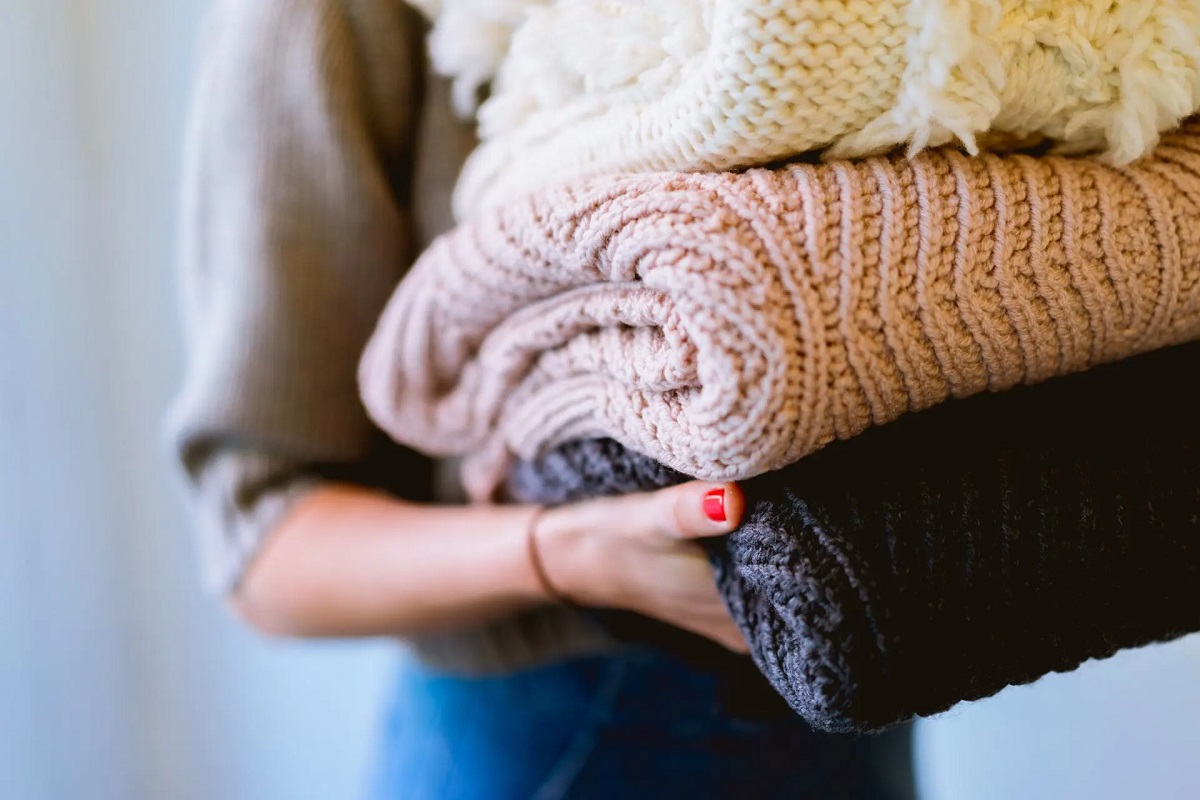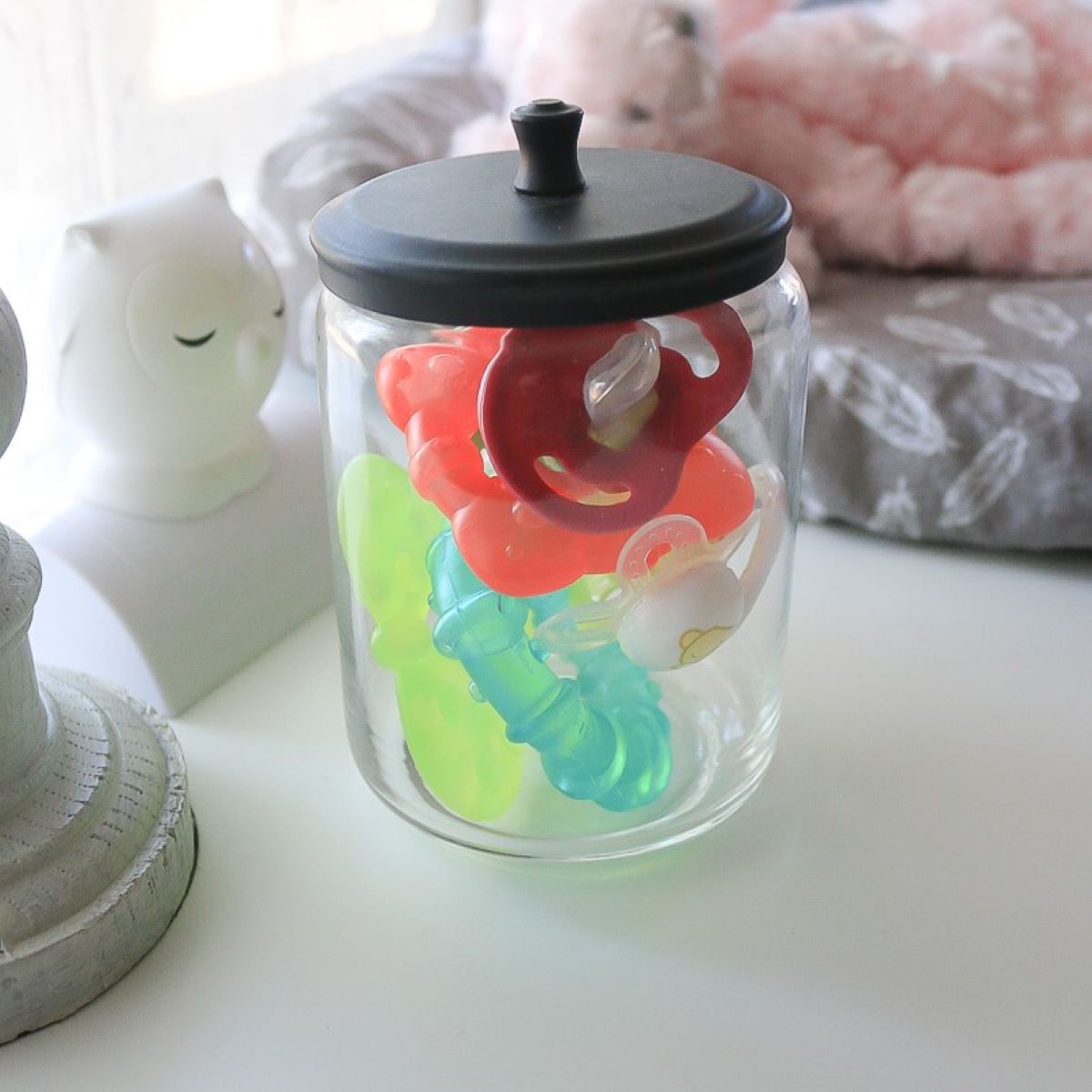

Articles
How To Store Knitwear
Modified: October 20, 2024
Discover the best techniques for storing your knitwear articles and keep them in perfect condition. Find tips on folding, organizing, and preserving your favorite pieces.
(Many of the links in this article redirect to a specific reviewed product. Your purchase of these products through affiliate links helps to generate commission for Storables.com, at no extra cost. Learn more)
How To Store Knitwear
Key Takeaways:
- Properly storing knitwear is crucial for maintaining quality and longevity. From cleaning and inspecting before storage to choosing the right storage method, attention to detail ensures knitwear remains in excellent condition.
- Protecting knitwear from moths and pests is essential for preserving its quality. Using natural repellents, sealing storage containers, and periodic checks help safeguard garments and prevent damage.
Read more: How To Store Store-Bought Bread
Introduction
Properly storing your knitwear is essential for maintaining its quality and prolonging its lifespan. Whether you have a collection of cozy sweaters, stylish cardigans, or delicate knit accessories, following the right storage techniques will ensure they stay in excellent condition. In this article, we will explore the steps and methods you can use to store your knitwear effectively.
When it comes to knitwear, proper storage is important due to its delicate nature. Knit fabrics are prone to stretching, snagging, and pilling, especially if not stored correctly. By using the right methods, you can protect your knitwear from damage and keep it looking and feeling its best.
Prepare for Storage
The first step in storing your knitwear is to ensure it is clean and free from any stains or odors. Before packing it away, carefully wash or dry clean each item according to the care instructions. This will prevent dirt, oils, or any other substances from setting into the fabric during storage.
Additionally, inspect your knitwear for any signs of damage, such as loose threads, holes, or snags. Repair these issues before storing to prevent them from worsening while in storage. Taking the time to mend any damaged areas will help preserve the quality and appearance of your knitwear.
Importance of Proper Knitwear Storage
Properly storing your knitwear is crucial for several reasons. Firstly, knit fabrics are more delicate compared to other types of clothing materials. They are prone to stretching, snagging, and pilling, which can significantly diminish their appearance and quality if not handled with care.
By following appropriate storage methods, you can minimize these risks and ensure that your knitwear remains in excellent condition. The right storage techniques will help maintain the shape, color, and overall integrity of your knitted garments, allowing you to enjoy them for years to come.
Prepare for Storage
Before you start storing your knitwear, it is important to take a few preparatory steps to ensure optimal care. The first step is to clean your knitwear thoroughly. This can be done by either hand-washing or dry cleaning, depending on the care instructions provided by the manufacturer.
When cleaning, use mild detergents or gentle fabric cleaners specifically designed for wool or knit fabrics. Avoid using harsh chemicals or bleach, as they can weaken the fibers and cause damage. Once cleaned, allow your knits to air dry completely before moving on to the next step.
In addition to cleaning, it is essential to inspect your knitwear for any signs of damage. Look for loose threads, holes, or snags. If you identify any issues, take the time to mend them before storing. This will prevent further damage and ensure that your knitwear remains in good condition while in storage.
By thoroughly cleaning and inspecting your knitwear before storage, you can help prevent stains, odors, and deterioration, ensuring that your garments will be in their best possible state when you retrieve them for future use.
Read more: How To Store Basil From Grocery Store
Prepare for Storage: Clean Your Knitwear
One of the most crucial steps in preparing your knitwear for storage is ensuring it is clean. Before packing away your precious knits, take the time to thoroughly clean each item to remove any dirt, oils, or stains that may have accumulated over time.
The specific cleaning method will depend on the care instructions provided by the manufacturer for each individual knitwear item. In some cases, hand-washing may be recommended, while in others, dry cleaning may be the preferred method. It is essential to follow these instructions to avoid damaging the fibers or altering the shape of the garment.
If hand-washing is recommended, fill a basin with lukewarm water and add a gentle wool or knitwear detergent. Submerge the knitwear in the water and gently swirl it around, ensuring that the water and detergent penetrate the fibers. Avoid excessive agitation, as this can cause stretching or distortion.
After a few minutes of soaking, gently squeeze the knitwear to remove excess water. Avoid wringing or twisting, as this can damage the fibers. Rinse the garment under running water until no soap residue remains.
When it comes to drying, avoid high heat sources such as radiators or direct sunlight, as they can cause shrinking or color fading. Instead, lay the knitwear flat on a clean, absorbent towel and gently roll it up to remove excess water. Then, reshape the garment to its original shape and lay it flat on a drying rack or clean towel.
Allow your knitwear to air dry completely before proceeding to the next steps. This may take several hours or even overnight, depending on the thickness and composition of the knit. Ensure that the garment is completely dry to prevent the growth of mildew or unpleasant odors.
By properly cleaning your knitwear before storage, you can remove any dirt or contaminants that could potentially cause damage or attract pests. Additionally, clean garments are less likely to develop stains or odors while in storage, keeping them fresh and ready for future use.
Inspect for Damage
Before storing your knitwear, it is important to inspect each item for any signs of damage. This includes loose threads, holes, snags, or any other issues that could worsen during storage.
Take the time to carefully examine each garment and address any issues you find. If you come across loose threads, carefully trim them with a pair of sharp scissors to prevent them from unraveling further. For small holes or snags, you can use a needle and thread to mend them, reinforcing the area and preventing it from getting bigger.
It’s also a good idea to check for any stains or discoloration on your knitwear. If you notice any, take appropriate measures to remove the stains before storage. Follow the care instructions and use a spot cleaner or a gentle stain remover specifically designed for knit fabrics.
Inspecting for damage is important because storing damaged knitwear can exacerbate the issues. It can lead to further unraveling of loose threads or the expansion of small holes, making the repairs more challenging once you retrieve the garments for use.
Choosing the Right Storage Method
Once you have cleaned and inspected your knitwear, it’s time to decide on the best storage method. The choice between folding and hanging your knitwear depends on the type of garment and the available space.
Folding: Folding is generally the preferred method for knitwear, as it helps maintain the shape and decreases the likelihood of stretching. Gently fold each garment, aligning the edges, and avoid creasing or bending too harshly. Stack the folded items neatly in a storage container or drawer.
Hanging: Some knitwear items, such as cardigans or lightweight sweaters, can be hung to prevent stretching. However, it is essential to use appropriate hangers to avoid misshaping the garments. Opt for padded or velvet hangers that provide more support and avoid using wire hangers that can leave marks or cause shoulder bulges.
Regardless of whether you choose to fold or hang your knitwear, it is essential to use proper storage options to protect the garments from dust, moths, and other potential damage. Consider the following storage methods:
- Drawer Storage: If you have enough drawer space, storing your knitwear in drawers can help protect them from light, dust, and pests. Fold each garment neatly and place them in separate drawers, ensuring they are not overcrowded.
- Vacuum-Sealed Bags: Vacuum-sealed bags are a popular option for storing knitwear, as they provide protection from dust, insects, and moisture. However, be cautious when using them for delicate or delicate knitwear, as the compression can lead to deformation or stretching of the fibers.
- Garment Bags: Garment bags with breathable fabric are a great alternative if you prefer to hang your knitwear. These bags provide protection while allowing airflow to prevent moisture buildup. Hang your knitwear inside the garment bags and ensure they are properly closed to keep out dust and pests.
When considering storage methods, always prioritize breathability and protection to maintain the quality of your knitwear throughout their time in storage.
Folding vs. Hanging
When it comes to storing knitwear, one common dilemma is whether to fold or hang the garments. Both methods have their advantages and considerations, and the decision ultimately depends on the type of knitwear and the available storage space.
Folding: Folding knitwear is generally recommended as it helps maintain the shape and structure of the garments. When folding, make sure to align the edges and avoid creasing or bending too harshly. Here are some reasons why folding your knitwear can be beneficial:
- Preserves shape: By folding your knits, you minimize the risk of stretching and misshaping. This is particularly important for bulky or heavy sweaters that can lose their form when hung for an extended period.
- Saves space: Folding allows you to maximize your storage space, especially if you have limited closet or drawer space. You can neatly stack folded items in a storage container or drawer, making efficient use of the available area.
- Avoids hanger marks: Hanging knitwear on the wrong type of hangers can sometimes leave marks or indentations on the shoulders. Folding eliminates this risk and ensures your knitwear remains free from unwanted creases or distortions.
Hanging: While folding is the preferred method, some knitwear items can be safely hung, particularly lightweight sweaters or cardigans. Here are some considerations for hanging your knitwear:
- Prevents wrinkles: Hanging prevents the formation of wrinkles or fold lines that may occur when knitwear is folded for an extended period.
- Facilitates easy access: Hanging your knitwear can make it easier to see and select the desired item, especially if you have a well-organized closet with appropriate hanging space.
- Allows for proper ventilation: Hanging knitwear allows air to circulate around the garments, reducing the chances of developing musty odors or moisture-related issues.
Regardless of whether you choose to fold or hang your knitwear, it is essential to handle them with care. Be mindful of the weight and delicacy of your garments, and choose appropriate folding or hanging methods to maintain their form and integrity.
Remember, different knitwear items may require different storage methods. For instance, heavy sweaters are best folded to avoid stretching, while delicate shawls or scarves can be hung to prevent wrinkles. Assess each piece individually and determine the most suitable storage method to ensure the optimal condition and longevity of your knitwear collection.
Read more: How To Store Gardasil
Different Storage Options
When it comes to storing your knitwear, there are various storage options to choose from. Each option offers its own benefits and considerations, allowing you to find the one that best suits your needs, available space, and the type of knitwear you have. Here are some different storage options to consider:
Drawer Storage
Drawer storage is an excellent choice for keeping your knitwear neatly organized and protected. If you have enough drawer space, this option provides a convenient and efficient way to store your garments. Here are some key advantages of drawer storage:
- Protection: Storing knitwear in drawers helps shield them from light, dust, and potential damage from pests. It keeps your garments out of sight and ensures they remain in good condition.
- Maximized space: Utilizing drawers allows you to take advantage of vertical storage space, making efficient use of the available area in your closet or dresser.
- Easy accessibility: With drawer storage, you can easily see and access your knitwear. Fold each garment neatly and place them in separate drawers, ensuring they are not overcrowded.
Vacuum-Sealed Bags
Vacuum-sealed bags are a popular storage option for knitwear, especially when space is limited. These bags offer protection from dust, insects, and moisture. However, consider the following factors when using vacuum-sealed bags:
- Preservation of space: Vacuum-sealed bags compress your knitwear, reducing the amount of space they take up. This can be particularly beneficial when storing bulky sweaters or large knit blankets.
- Protection: These bags create an airtight seal, preventing dust, moths, and other pests from reaching your garments. However, be cautious when using vacuum-sealed bags for delicate or fragile knitwear, as the compression may cause deformation or stretching of the fibers.
- Consideration for long-term storage: Vacuum-sealed bags can be great for short-term storage or when space is a concern. However, for long-term storage, it is recommended to allow your knitwear to breathe to maintain their quality and shape.
Garment Bags
Garment bags are a valuable option, especially if you prefer to hang your knitwear. These bags provide protection while allowing airflow, ensuring your garments are shielded from dust and pests while maintaining proper ventilation. Here are some advantages of using garment bags:
- Breathability: Garment bags with breathable fabric allow air to circulate around your knitwear, preventing moisture buildup and musty odors.
- Protection: Garment bags act as a barrier against dust, light, and potential damage from moths or other pests. Hang your knitwear inside the bags, ensuring they are properly closed to keep out any external elements.
- Easy organization: Garment bags with transparent windows or labels make it easy to identify and find specific items within your collection.
Consider your specific storage needs and the type of knitwear you have when deciding on the best storage option. Regardless of the method you choose, ensure your knitwear is clean, dry, and properly folded or hung to maintain its quality during storage.
Read more: How To Store Parsley
Drawer Storage
Drawer storage is an excellent option for keeping your knitwear organized and protected. If you have enough drawer space in your closet or dresser, utilizing drawers for storing your knitwear offers several benefits. Here are some key advantages of drawer storage:
- Protection from dust and light: Storing your knitwear in drawers helps shield them from dust and light exposure, which can cause fading of colors and deterioration of the fabric over time. It keeps your garments hidden, protecting them from potential damage.
- Maximized space: Utilizing drawers allows you to make efficient use of the vertical storage space in your closet or dresser. You can stack your folded knitwear neatly, making the most of the available area.
- Ease of accessibility: With drawer storage, you have easy access to your knitwear. Each garment can be folded neatly and placed in separate drawers, ensuring they are not overcrowded. This makes it simple to find and retrieve the item you desire without disturbing the rest of the collection.
- Organization: Drawer storage allows you to create a dedicated space for each type of knitwear, making it easier to sort and arrange them. You can organize by garment type, color, or any other categorization that suits your preference. This helps maintain a sense of order and simplifies the process of finding the desired item.
- Protection from pests: Storing your knitwear in closed drawers offers protection against pests such as moths, which can cause damage to the fibers. Ensure the drawers are clean and free from any food particles or potential attractants that could invite pests.
To make the most of drawer storage, it’s important to fold your knitwear properly. Fold each item carefully, aligning the edges and ensuring it lays flat without excessive creasing or bending. Avoid overstuffing the drawers, as this can lead to wrinkling and distortion of the garments. If space allows, dedicate specific drawers for different types of knitwear to maintain organization and ease of access.
Remember to periodically check your knitwear in the drawers, ensuring they remain in good condition. If any issues arise, such as loose threads or small holes, address them promptly to prevent further damage. By utilizing drawer storage for your knitwear, you can keep your garments protected, organized, and easily accessible, ensuring they stay in excellent condition for years to come.
Vacuum-Sealed Bags
Vacuum-sealed bags are a popular storage option for knitwear, especially when space is limited. These bags offer a range of benefits and can help protect your garments from dust, insects, and moisture. Here’s why vacuum-sealed bags are worth considering for storing your knitwear:
- Space-saving: One of the primary advantages of vacuum-sealed bags is their ability to compress your knitwear, reducing the amount of space they occupy. By removing the air from the bags, you can significantly minimize the volume of your garments, allowing for more efficient storage.
- Protection from dust and pests: Vacuum-sealed bags provide airtight protection, guarding your knitwear against dust, dirt, and potential damage from pests such as moths. This helps keep your garments clean and in pristine condition while in storage.
- Moisture prevention: These bags also help prevent moisture build-up, which is particularly important if you live in a humid climate. By creating a sealed environment, vacuum-sealed bags minimize the chances of mold or mildew growth on your knitwear.
- Easy identification: Many vacuum-sealed bags are transparent, allowing you to see the contents without having to open them. This makes it easy to identify specific garments within the bags, saving you time and effort when searching for a particular item.
- Considerations for delicate knitwear: While vacuum-sealed bags provide excellent protection, it’s important to consider the nature of your knitwear. Delicate or fragile knit fabrics, such as cashmere or lace, may be more susceptible to compression and deformation. If you have exceptionally delicate pieces, opt for alternative storage methods such as folding or hanging with care.
When using vacuum-sealed bags, it’s essential to follow a few guidelines to ensure the longevity of your knitwear. Firstly, make sure your garments are clean and completely dry before placing them in the bags to prevent any potential moisture or odor issues. Be careful not to overfill the bags, as excessive compression can cause unnecessary pressure on the fibers, leading to stretching or distortion. Finally, avoid storing knitwear in vacuum-sealed bags for extended periods, as allowing them to breathe periodically is recommended for maintaining their overall quality.
Vacuum-sealed bags can be particularly useful for storing bulkier knitwear items such as sweaters or blankets. However, it’s important to assess the specific needs of your garments and consider the potential effects of compression before opting for this storage method. By using vacuum-sealed bags cautiously and for the appropriate knitwear, you can maximize space while still ensuring the continued preservation of your favorite knit pieces.
To store knitwear, fold it instead of hanging to prevent stretching. Use breathable storage containers or cotton garment bags to protect from moths and dust. Avoid using plastic bags, as they can trap moisture.
Garment bags
Garment bags are a practical storage option for your knitwear, particularly when you prefer to hang your garments. These bags offer protection from dust, light, and potential damage, while allowing for proper air circulation. Here’s why garment bags are a great choice for storing your knitwear:
- Breathability: Garment bags are typically made from breathable fabrics, allowing air to circulate around your knitwear. This helps prevent moisture buildup and keeps your garments fresh and odor-free.
- Protection from dust and light exposure: Garment bags shield your knitwear from dust, which can accumulate on the surface of your garments and potentially cause damage. Additionally, they provide protection against prolonged exposure to light, which can cause fading or discoloration over time.
- Easy identification: Many garment bags feature transparent windows or labels, making it easy to identify and locate specific items without having to open each bag. This saves you time and effort when searching for a particular knitwear piece.
- Pest prevention: Garment bags act as a barrier, protecting your knitwear from potential damage caused by pests such as moths. Ensure that the bags are properly closed and sealed to keep out any unwanted intruders.
- Organized storage: Using garment bags helps keep your knitwear neatly organized within your closet. Hang your knitwear inside the bags, keeping similar items together or organizing them by color or season, making it easier to find the specific piece you’re looking for.
Organizing and Arranging Knitwear
Organizing and arranging your knitwear is essential for efficient storage and easy access. Here are some tips to help you effectively organize and arrange your knitwear:
- Sort by type, color, or season: Group your knitwear together based on common attributes, such as type (sweaters, cardigans, etc.), color, or season. This will make it easier to find the desired piece when you need it.
- Hang with care: When hanging your knitwear, use appropriate hangers to prevent misshaping or stretching. Opt for padded or velvet hangers that provide more support and avoid using wire hangers, which can leave marks or cause shoulder bulges.
- Allow space between hangers: To avoid overcrowding and wrinkling, ensure that there is sufficient space between hangers. This allows your knitwear to hang freely without excessive creasing or deformation.
- Use wardrobe dividers: If you have a large collection of knitwear, consider using wardrobe dividers to separate and categorize different types or seasons. This will make it easier to browse and locate specific items while keeping your closet neat and organized.
- Rotate your garments: To ensure that all your knitwear gets equal wear, periodically rotate the position of your garments on the hangers or within the garment bags. This prevents certain items from becoming neglected while others are frequently worn.
By organizing and arranging your knitwear thoughtfully, you can create a visually appealing and functional storage system. This not only makes it easier to find and retrieve your favorite pieces but also helps maintain the quality and longevity of your knitwear collection.
Read more: How To Store Cans
Sorting by Type or Color
When it comes to organizing your knitwear collection, sorting your garments by type or color can be a practical approach. This method of organization offers several benefits and can make it easier to locate specific items within your collection. Here’s why sorting by type or color is a helpful strategy for storing your knitwear:
- Easy identification: Sorting your knitwear by type or color allows for quick visual identification of specific garments. When you’re in a hurry or looking for a particular item, this system enables you to easily locate it amidst your collection.
- Ease of coordination: Sorting your knitwear by color facilitates outfit coordination. By grouping items of a similar hue together, you can effortlessly build cohesive and stylish outfits.
- Saves time: With a sorted collection, you won’t waste time rummaging through your entire knitwear stash looking for a specific piece. Instead, you can go straight to the section designated for the type or color you desire, streamlining your dressing routine.
- Preserves garment integrity: Sorting by type or color minimizes the handling and potential stretching of individual garments. When you’re searching for a specific item, you won’t disturb the others as much, helping to preserve their shape and quality.
- Enhances visual appeal: An organized storage system with knitwear grouped by type or color creates a visually pleasing display. It transforms your closet or storage area into a neat and aesthetically pleasing space.
To implement this sorting method, start by deciding whether you prefer to sort by type, color, or both. Consider your personal preferences and how you typically select your outfit. You may choose to sort by different types of knitwear, such as sweaters, cardigans, and accessories, or you might prefer to organize by color, grouping together similar hues or shades.
Once you’ve determined your sorting criteria, allocate specific areas or sections within your chosen storage space for each category. This could be shelves, hanging racks, or dedicated drawers. Use labels or dividers to clearly mark and separate the different sections, making it easier to maintain the organization over time.
Remember to periodically reassess and adjust your sorting system as your knitwear collection grows or changes. This will ensure that the organization remains effective and allows for any updates or additions to be seamlessly incorporated.
Sorting your knitwear by type or color is a simple yet impactful method of storage organization. It not only enhances your overall dressing experience but also helps keep your knitwear in top condition, ensuring that you maximize the enjoyment and longevity of each garment.
Storing in Layers
When it comes to storing your knitwear, arranging your garments in layers can help protect them and optimize the use of storage space. Storing in layers involves carefully stacking or layering your knitwear items on top of each other within your storage containers or drawers. Here’s why storing in layers is a beneficial approach:
- Maximizes space: Storing your knitwear in layers allows you to make the most of your storage space, especially if you have limited room. By stacking your garments, you can utilize the vertical space available without sacrificing accessibility.
- Provides cushioning: When you layer knitwear items, they can provide natural padding and cushioning for each other, reducing the risk of wrinkles and creases. This is especially advantageous for delicate knits that can easily lose their shape.
- Ensures proper weight distribution: Layering your knitwear helps distribute the weight evenly, preventing any one item from bearing the full load. This can help maintain the integrity of the garments, reducing the risk of stretching or distortion.
- Facilitates organization: Storing in layers allows you to easily see and access different pieces within your collection. You can arrange your knitwear by type, color, or season, creating visually appealing layers that make it simple to find specific items when needed.
- Protects from light exposure: Layering your knitwear items helps shield them from direct light exposure, minimizing the risk of color fading or damage caused by UV rays.
When storing in layers, it’s important to follow a few guidelines to ensure the longevity and condition of your knitwear. Consider the thickness and weight of each garment when arranging the layers to avoid excessive pressure on delicate items. Be mindful of pilling, as friction between garments can cause this common issue in knitwear. To minimize the risk, place a layer of lightweight, breathable fabric between garments.
If you are using drawers or storage containers, you may want to consider using dividers or separators to create distinct layers within the space. This will help maintain the organization and prevent garments from getting tangled or wrinkled.
Remember to periodically rotate your layered knitwear, bringing different pieces to the top of the stack to ensure each garment receives equal wear and maintains its shape. Additionally, avoid overpacking or overcrowding the layers, as this can lead to wrinkles, stretching, or difficulty in accessing specific items.
Maintaining Knitwear in Storage
Maintaining your knitwear while in storage is crucial for preserving its quality and ensuring that it remains in excellent condition. Here are some essential tips for maintaining your knitwear in storage:
- Periodic checking: Regularly inspect your stored knitwear to ensure there are no signs of damage, pests, or moisture accumulation. Take the time to check for any loose threads, holes, or stains that may have developed while in storage.
- Protection from moths and pests: Use preventive measures to protect your knitwear from moths and other pests that can cause damage to the fibers. Consider adding cedar balls or lavender sachets to your storage area, as these natural repellents can help deter pests. Alternatively, there are also specific moth-proofing products available on the market.
- Avoiding excessive folding: While folding is an effective storage method, excessive folding over long periods can lead to creases and wrinkles. To minimize this risk, periodically rearrange the folded garments to distribute the pressure points and prevent permanent creasing.
- Air circulation: Ensure your storage area has proper ventilation to prevent moisture buildup and musty odors. Avoid storing knitwear in airtight containers for extended periods, as allowing them to breathe periodically is recommended to maintain their quality.
- Seasonal rotation: Consider rotating your stored knitwear seasonally. As you transition from one season to another, swap out garments that are no longer in use and replace them with appropriate seasonal pieces. This allows each garment to have time to rest and breathe, preventing unnecessary wear and maintaining their overall quality.
By following these maintenance tips, you can ensure that your knitwear remains in optimal condition while in storage. Regular checks and preventive measures will help preserve the quality and extend the lifespan of your valuable knitwear collection.
Checking Periodically
When it comes to storing your knitwear, checking on your stored garments periodically is an important maintenance practice. Regularly inspecting your knitwear helps ensure that it remains in good condition and allows you to address any issues promptly. Here’s why checking your stored knitwear is essential:
- Identifying damage or issues: Periodic checks enable you to identify any signs of damage or issues that may have occurred while in storage. Look for loose threads, holes, or snags that may require immediate attention. By catching and addressing these problems early on, you can prevent further damage and prolong the life of your knitwear.
- Preventing pest infestation: Regular inspections can help you spot any signs of pests, such as moths or other insects, that may have found their way into your storage area. By catching pests early, you can take appropriate measures to prevent infestation and protect your knitwear from damage.
- Ensuring proper storage conditions: Checking your stored knitwear allows you to assess the storage conditions and make any necessary adjustments. Look for signs of excessive moisture, musty odors, or improper ventilation. If needed, take steps to improve the storage environment to maintain the quality of your garments.
- Rotating garments: Periodically checking on your knitwear gives you the opportunity to rotate the garments. By bringing different pieces to the forefront, you can ensure that all your knitwear gets equal wear and prevents certain items from being neglected or forgotten in storage.
- Identifying cleaning needs: Regular inspections help you determine if any garments require cleaning before being stored or if they need to be refreshed. Identifying stains, odors, or general wear and tear allows you to plan for proper cleaning and maintenance.
When conducting periodic checks, take the time to carefully examine each garment, paying attention to details. Unfold or unhang the knitwear pieces and inspect them in good lighting. Thoroughly examine the fabric, seams, and any decorative elements for any signs of damage or pests.
If you find any issues during your inspection, take appropriate action. Repair loose threads or small holes promptly, and consider professional cleaning for garments that require it. If you detect signs of pest activity, take measures to eliminate the pests and protect your other stored knitwear.
Make it a habit to check your stored knitwear at least a few times a year, and consider conducting more frequent checks in areas with higher pest activity or during seasonal transitions. By regularly inspecting your knitwear, you can ensure that your precious garments remain in excellent condition and are ready to wear when you retrieve them from storage.
Read more: How To Store Mounjaro
Protecting from Moths and Pests
When it comes to storing your knitwear, protecting it from moths and other pests is essential. These insects can cause significant damage to your garments, especially those made from natural fibers. Taking preventive measures to keep moths and pests at bay will help preserve the quality and integrity of your knitwear collection. Here’s how to protect your knitwear from moths and pests:
- Storage cleanliness: Keep your storage area clean and free from food particles, dust, or any substances that may attract pests. Regularly vacuum or clean the storage space to minimize potential food sources for pests.
- Natural repellents: Consider using natural repellents like cedar balls or lavender sachets in your storage area. These scents are known to repel moths and help deter other pests. Place them in drawers, closets, or storage containers to provide an extra layer of protection.
- Seal openings: Ensure that any openings or gaps in your storage containers or drawers are properly sealed. This prevents pests from finding their way in and damaging your knitwear.
- Avoid storing soiled garments: Before storing your knitwear, ensure that each piece is clean and free from stains. Moths are attracted to natural fibers, food stains, and perspiration, so it’s important to store your garments in a clean and fresh state.
- Periodic checks: Regularly inspect your stored knitwear for any signs of moths or pests. Look for eggs, larvae, or adult insects. If you notice any signs of infestation, take immediate action to prevent further damage.
- Freezing or heat treatment: If you suspect the presence of pests in your stored knitwear, you can take precautionary measures by freezing or heat-treating the garments. Freezing your knitwear at -18°C (0°F) for several days or heat-treating them at high temperatures can help eliminate any pests or eggs that may be present.
By implementing these protective measures, you can greatly reduce the risk of moth and pest damage to your knitwear collection, and ensure that your garments remain in excellent condition for years to come.
Conclusion
Properly storing your knitwear is crucial for maintaining its quality and prolonging its lifespan. By following the appropriate storage methods, such as cleaning and inspecting your knitwear before storage, choosing the right storage option, organizing and arranging your garments, and periodically checking on them, you can ensure that your knitwear remains in excellent condition.
Whether you opt for drawer storage, vacuum-sealed bags, or garment bags, each method offers its own benefits. Sorting your knitwear by type or color helps with organization and ease of access. Storing in layers maximizes space and provides cushioning while maintaining proper weight distribution. Regularly checking your stored knitwear allows you to address any issues and prevent potential damage. Protecting your garments from moths and pests ensures their longevity and preserves their quality.
Remember, a little extra care and attention to storage can go a long way in keeping your knitwear in optimal condition. By implementing these tips and techniques, you can enjoy your favorite knitwear pieces for many seasons to come.
Frequently Asked Questions about How To Store Knitwear
Was this page helpful?
At Storables.com, we guarantee accurate and reliable information. Our content, validated by Expert Board Contributors, is crafted following stringent Editorial Policies. We're committed to providing you with well-researched, expert-backed insights for all your informational needs.











0 thoughts on “How To Store Knitwear”